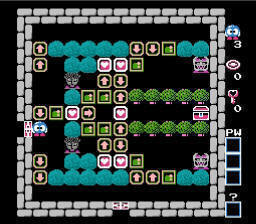 Somewhere well beyond all of the violent fighting games and endless
first-person shooters and even beyond such twitchy intellectual playthings as
Qix and Tetris, there lies a certain quiet genre of puzzle games. The spiritual
descendants of things like chess and the old puzzle-boxes of yore, these games
simply present you with a series of challenges, a set of clear rules, and
occasionally a cute and fuzzy main character. And the only way to make it
through it all is to think.
Somewhere well beyond all of the violent fighting games and endless
first-person shooters and even beyond such twitchy intellectual playthings as
Qix and Tetris, there lies a certain quiet genre of puzzle games. The spiritual
descendants of things like chess and the old puzzle-boxes of yore, these games
simply present you with a series of challenges, a set of clear rules, and
occasionally a cute and fuzzy main character. And the only way to make it
through it all is to think.
One of the high points of this genre was the well-known Adventures of Lolo trilogy for the NES, a creation of HAL Laboratory. What is relatively unknown is that The Adventures of Lolo had its debut back on the Japanese MSX in a simplistic game known as Eggerland Mystery. This was eventually followed by Eggerland Mystery for the Famicom Disk system, and finally by Eggerland Mystery Revival (or Eggerland Meikyuu no Fukkatsu) for the Famicom. It is this last game, the immediate predecessor of The Adventures of Lolo, that is the subject of this review.
As you might have guessed, Eggerland Mystery Revival stars a cute and fuzzy blue thing named Lolo. Lolo's girlfriend Lala has apparently been kidnapped and, rather than being sensibly placed at the termination of a multitude of side-scrolling levels, has been hidden deep with a labyrinth of puzzling little rooms, viewed from a top-down perspective. In this case, each room contains a variety of enemies (each of which naturally obeys a set of clear rules), a number of "heart framers" and "emerald framers", and a treasure chest. Collect all the heart framers and the treasure chest will open; touch the open chest, and you can move on to the next room.
Of course, it is in negotiating with those enemies and those sets of clear rules that the challenge lies. Lolo's enemies include Snakey, who simply sits in one place and does nothing; Leeper, who jumps around and goes to sleep when he touches Lolo; Medusa, who kills Lolo as soon as he crosses her line of sight; and Lamola, who actively chases Lolo.
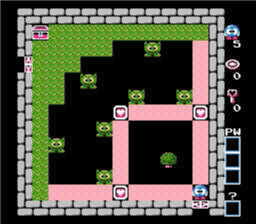 Often, care must be taken when choosing the order in which to pick up the
heart framers. Heart framers obstruct enemy movements, as well as the line of
sight of enemies like Medusa. Some heart framers also contain tools such as
magic shots. Lastly, some enemies such as Gol and Skull only become active
once the last framer is picked up and treasure chest is open: the former starts
spitting fireballs, while the second starts chasing Lolo.
Often, care must be taken when choosing the order in which to pick up the
heart framers. Heart framers obstruct enemy movements, as well as the line of
sight of enemies like Medusa. Some heart framers also contain tools such as
magic shots. Lastly, some enemies such as Gol and Skull only become active
once the last framer is picked up and treasure chest is open: the former starts
spitting fireballs, while the second starts chasing Lolo.
The primary tool in Lolo's quest are the ubiquitous emerald framers: ordinary green boxes that can be harmlessly pushed throughout a level. Many times emerald framers simply get in the way, but like heart framers, they can obstruct enemy movements and hide Lolo from Medusa's all-seeing eye. The aforementioned magic shots are also of vital importance. A single shot transforms an enemy into an egg, which serves many of the same purposes of an emerald framer and can also be pushed into water to briefly serve as a raft. An egg will quickly hatch and re-form into an enemy, but Lolo can buy a little more time by shooting an egg, sending it off the screen completely (with a rather nice graphical effect) and forcing the enemy to re-appear only after a much longer period of time. Naturally, you must make every shot count.
It is unnecessary to get into the game's other features (such as one-way tiles, grass, sand, trees, and boulders) at this time. It is sufficient to say that many of the game's conventions can be discovered relatively quickly through some trial and error, and soon enough you will know all about blocking Medusas, shooting Lamolas, trapping Skulls, and all the other techniques needed to work through the game's 150+ rooms. The question is, do you want to?
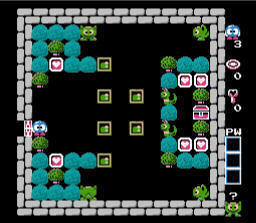 There is nothing immediately off-putting about Eggerland Mystery Revival. The
graphics are clean and crisp, and it is easy to tell objects apart from one
another. While most of the puzzle rooms look basically the same, there are
several different background tunes used during the game, all of which are easy
to listen to for extended periods of time. The sharpest contrast between this
game and The Adventures of Lolo may be that the backgrounds are all completely
black as opposed to more varied textures, but the overall aesthetic is not
unpleasant. A nice touch is that you occasionally has a choice as to which
room to tackle next, so that even if you get completely stuck somewhere you can
try a different room. (Unfortunately, this means you need to write down a
twenty-character password to record your progress.)
There is nothing immediately off-putting about Eggerland Mystery Revival. The
graphics are clean and crisp, and it is easy to tell objects apart from one
another. While most of the puzzle rooms look basically the same, there are
several different background tunes used during the game, all of which are easy
to listen to for extended periods of time. The sharpest contrast between this
game and The Adventures of Lolo may be that the backgrounds are all completely
black as opposed to more varied textures, but the overall aesthetic is not
unpleasant. A nice touch is that you occasionally has a choice as to which
room to tackle next, so that even if you get completely stuck somewhere you can
try a different room. (Unfortunately, this means you need to write down a
twenty-character password to record your progress.)
As you can imagine, Lolo dies often, although the unlimited continues make the whole point of "lives" somewhat moot. If one messes up a room completely (by pushing an emerald framer into the wrong spot or by misusing one's magic shots, for instance), one can reset the room by exiting it from the way one came in and re-entering; however, if the exit is blocked by something, one's only solution is to commit suicide.
What really matters is whether the level design and the rules of the game allow for a pleasing puzzle experience, that sense of satisfaction after overcoming a particularly arduous level. In this sense, Eggerland Mystery Revival may fall short, as too many levels are dependent on overly precise movements, old-fashioned twitch gameplay, and sometimes just trial and error.
There are plenty of levels in which objects like an emerald framer or egg must be pushed to exactly the right position in exactly the right way in order to properly shield Lolo from the dangers around him. Lolo moves exactly half a space whenever one taps the control pad (as does an egg or emerald framer that he may be pushing), meaning that there can be a lot of precision moving necessary. The Leepers can be particularly problematic, as they too must sometimes be induced to fall asleep at precise positions with no margin for error. When these precise movements have to be coordinated with the rather fast motions of a number of enemies, frustrations can rise quickly.
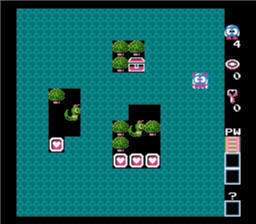 The trial-and-error aspect of the puzzles comes primarily from the annoying
fact that it is impossible to solve many levels simply by looking at a single
picture of them. For instance, as previously mentioned, eggs can be pushed
into bodies of water where they can be ridden or used as shields as they float
around. Unfortunately, the currents the eggs follow in the water (and the
places where they will immediately sink) are completely invisible if no egg is
floating in them. Often, one may find it necessary to push an egg into every
available spot in a body of water in order to discover just where the eggs will
go and how they can be used to finish the level. As a large portion of the
middle of the game takes place on a series of small islands, this trial and
error can grow tiresome fast.
The trial-and-error aspect of the puzzles comes primarily from the annoying
fact that it is impossible to solve many levels simply by looking at a single
picture of them. For instance, as previously mentioned, eggs can be pushed
into bodies of water where they can be ridden or used as shields as they float
around. Unfortunately, the currents the eggs follow in the water (and the
places where they will immediately sink) are completely invisible if no egg is
floating in them. Often, one may find it necessary to push an egg into every
available spot in a body of water in order to discover just where the eggs will
go and how they can be used to finish the level. As a large portion of the
middle of the game takes place on a series of small islands, this trial and
error can grow tiresome fast.
Some levels further depend on a gameplay quirk whose effects are also impossible to discern at a glance. If an enemy is shot once (to turn it into an egg) and shot again (thus removing it from the screen), it will normally re-appear in its initial position after a while. If another enemy or emerald framer is placed in its initial position, the enemy will either be completely obliterated (signaled by a brief but audible sound) or will reappear at a set position elsewhere in the level. This process can be repeated to send an enemy to other parts of the level where it would not normally be possible to place it. Once again, it is impossible to discern this behavior at a glance, and one may end up going through a great deal of trouble shooting different enemies and placing objects in their initial positions to find the solution to a puzzle.
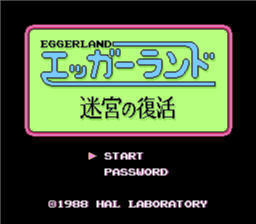 As if all this isn't bad enough, Eggerland Mystery Revival sometimes throws
real curveballs: levels that defy the game's own rules! Several levels place
completely insurmountable obstacles between Lolo and his goals, and the only
way to overcome them is to complete some bizarre maneuver that, once again, can
only be discovered through trial and error. The only clue provided is a small
picture of an object in the lower-right corner of the screen, suggesting that
one must manipulate similar objects to finish the level. On rare occasions,
the goal is intuitive; one clever level, for instance, requires you to collect
all the heart framers in a level while not touching a Leeper that follows you
around. A much less pleasant level requires you to push emerald framers into a
specific (and nearly unknowable) pattern. Once the goal is achieved, some
magic powerup appears that, say, gives Lolo unlimited magic shots or lets him
walk through walls, allowing the level to be completed properly. Suffice it to
say, these kinds of levels are probably enough to make many players give up
entirely.
As if all this isn't bad enough, Eggerland Mystery Revival sometimes throws
real curveballs: levels that defy the game's own rules! Several levels place
completely insurmountable obstacles between Lolo and his goals, and the only
way to overcome them is to complete some bizarre maneuver that, once again, can
only be discovered through trial and error. The only clue provided is a small
picture of an object in the lower-right corner of the screen, suggesting that
one must manipulate similar objects to finish the level. On rare occasions,
the goal is intuitive; one clever level, for instance, requires you to collect
all the heart framers in a level while not touching a Leeper that follows you
around. A much less pleasant level requires you to push emerald framers into a
specific (and nearly unknowable) pattern. Once the goal is achieved, some
magic powerup appears that, say, gives Lolo unlimited magic shots or lets him
walk through walls, allowing the level to be completed properly. Suffice it to
say, these kinds of levels are probably enough to make many players give up
entirely.
On the whole, Eggerland Mystery Revival can still be a rewarding experience. It is no small feat to put together a set of rules that is easy to learn but still allows for complex, varied gameplay. Nonetheless, it's a shame that so many of the rooms are challenging simply because it takes so long to explore all of one's options, and there is no excuse whatsoever for the rule-defying rooms. If you don't have an immense amount of patience, you might be better off with one of those fighting games or first-person shooters after all.
